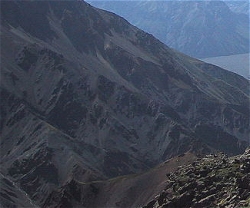
March Editorial
Global freezing

March Editorial
Global freezing
|
"Snowball Earth" is a term coined by Joseph Kirschvink, a professor of geobiology at the California Institute of Technology. This refers to a theory that during the Cryogenian period (between 650 and 750 million years ago) the Earth was completely frozen at least once. The two largest glaciations ever recorded, the Sturtian and Marinoan, occurred during this period. It is a topic of considerable debate as to whether the glaciation was truly global - i.e. there was indeed a 'snowball earth'; or whether the observed glaciation consisted of many local events which left substantial parts of the planet ice-free.
Recent results from a geological study of rocks from the Yukon in north-west Canada have now provided another piece of evidence which supports the 'snowball Earth' theory. | |
|
Francis A. Macdonald and his colleagues from the Department of Earth and Planetary Sciences at Harvard University analyzed a sample of ancient rocks from the Yukon. They used a high precision Uranium-Lead (U-Pb) carbon dating technique on rocks with glacial deposits and other signs of glaciation, such as striated clasts, ice rafted debris, and deformation of soft sediments. These purplish glacial deposits were found on top of old reef material composed of carbonate, which shifted north with the movement of tectonic plates to its current location. The magnetic and chemical composition of the rocks suggests that they were originally located at sea level in the tropics — at about 10 degrees latitude. The results of the study, with clear evidence of glaciation in the rocks, were published in Science this month (vol 327, pp 1241-1243). They explain that this is direct evidence that the Sturtian glaciation did indeed stretch as far as the tropics and thus was a true 'snowball Earth' event. Carbon dating showed that this global glaciation lasted for at least five million years, though other tests from fossils and mineral isotopes suggest that the Sturtian glaciation might even have lasted as long as 20 million years, from 720 million to 700 million years ago. The evidence from fossils also suggests that all of the major eukaryotic groups, with the possible exception of animals, were present before the Sturtian glaciation and survived throughout the glacial period. Which brings one of the most difficult question to answer - how did they survive? For these microscopic species to survive through the 'snowball Earth' event, sunlight and surface water must have been available. But Macdonald has an answer to this as well. He says: 'Even on a snowball Earth, there would be temperature gradients and it is likely that ice would be dynamic: flowing, thinning, and forming local patches of open water, providing a refuge for life.' 'From an evolutionary perspective', he adds, 'it's not always a bad thing for life on Earth to face severe stress.' Reference:
| |
| _______________________________ | ||||
| Home | | | Shopping | | | Database |
© Biscuit Software 2004-2015
All rights reserved